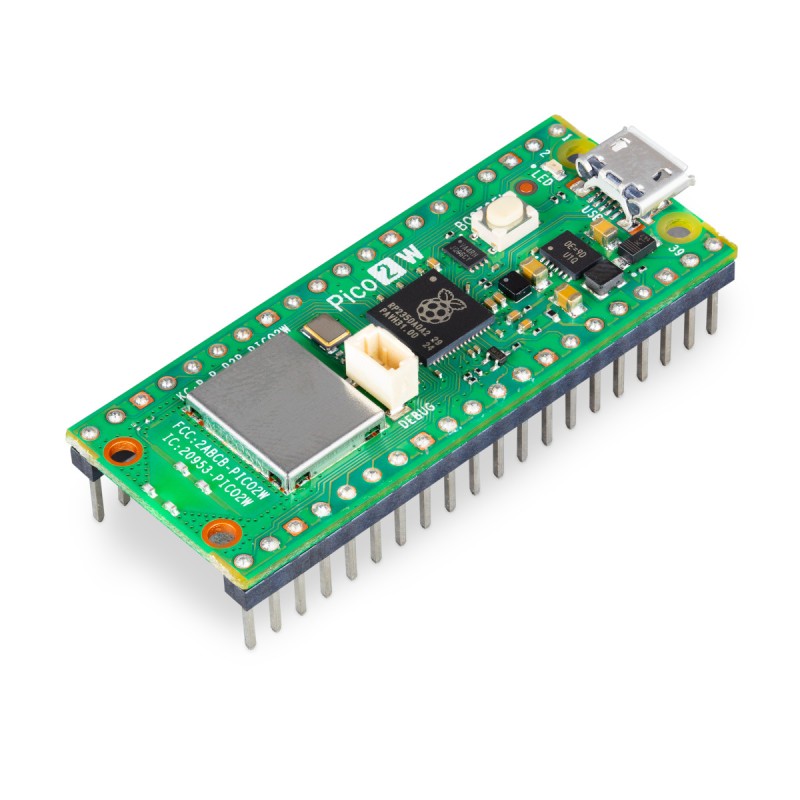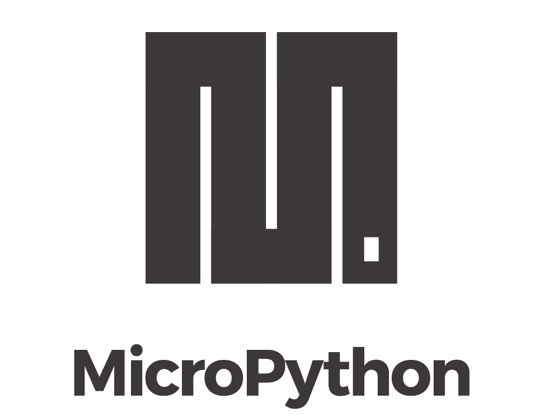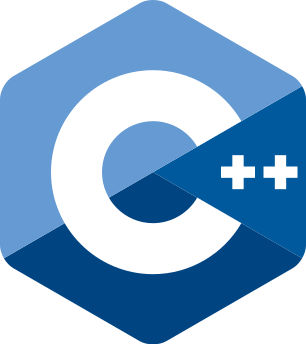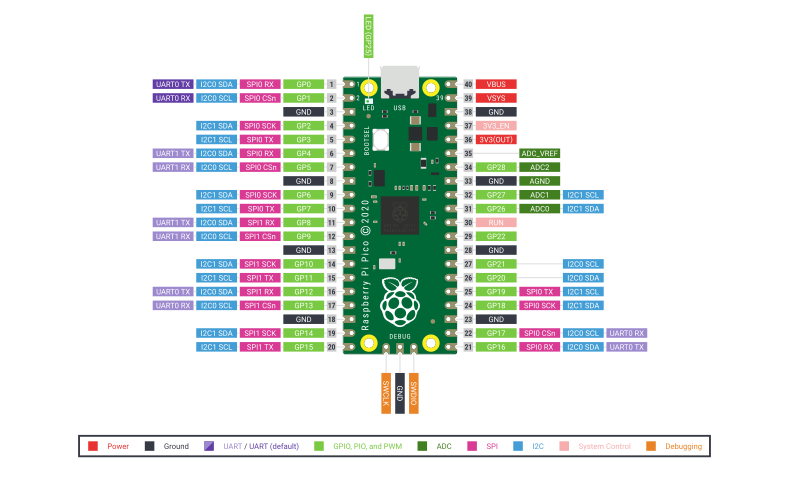



zł34.13 tax excl.
Raspberry Pi Pico 2WH, based on the RP2350 microcontroller and has a built-in WiFi and Bluetooth communication module. Pi Pico 2WH offers significantly increased performance and functionality thanks to the use of Cortex M33 and RISC-V cores, doubled SRAM memory and advanced security features, including Arm TrustZone. It is hardware and software compatible with previous models, making it an attractive choice for enthusiasts and professionals in the field of embedded systems. Version with soldered joints.
Raspberry Pi Pico 2WH is a development board based on the RP2350 microcontroller, designed with high performance and security in mind. Pi Pico 2WH, compared to the previous version, is characterized by the use of Cortex M33 cores with a higher clock speed, two additional RISC-V cores, doubling the SRAM and memory. In addition, the second version of the iconic board introduces new security features and improved interface capabilities. Additionally, the board is equipped with the Infineon CYW43439 system, extending the board with wireless connectivity. The module provides WiFi connectivity in the IEEE 802.11 b / g / n standard. Raspberry Pi Pico 2WH offers a significant increase in performance and functionality while maintaining hardware and software compatibility with earlier models of the Raspberry Pi Pico series. Version with soldered joints.
The RP2350 system offers advanced security features based on Arm TrustZone for Cortex-M technology, including digitally signed boot, 8 KB of OTP antifuse memory for storing keys, SHA-256 acceleration, a hardware TRNG random number generator and fast error detectors. These features, along with the secure boot ROM, are well documented and available to all users, allowing professionals to seamlessly integrate the RP2350 and Raspberry Pi Pico 2 into their projects.

Kamami is the official distributor of Raspberry Pi minicomputers and dedicated accessories.
| Raspberry Pi Pico | Raspberry Pi Pico 2 | |
|---|---|---|
| Microcontroller | RP2040 | RP2350 |
| Core | 2 x ARM Cortex M0+ 133 MHz |
2 x ARM Cortex M33 150 MHz 2 x RISC-V Hazard3 |
| RAM | 256 kB | 520 kB |
| Flash | 2 MB | 4 MB |
| Communication interfaces |
2 x SPI 2 x I2C 2 x UART 3 x 12-bit ADC 16 kanałów PWM 8 x PIO |
2 x SPI 2 x I2C 2 x UART 3 x 12-bit ADC 24 kanały PWM 12 x PIO |
| Programmer interface | USB 1.1 / SWD | USB 1.1 / SWD |
| Security features | - |
Arm TrustZone for Cortex-M Digitally signed boot |
| Supply voltage | 1,8 – 5,5 V | 1,8 – 5,5 V |
| Dimensions | 51 x 21 mm | 51 x 21 mm |

MicroPython is a special version of the Python 3 programming language, prepared to run directly on embedded systems such as the Raspberry Pi Pico. The version prepared especially for the RP2350 microcontroller, supports REPL, an interactive shell that allows you to execute scripts, typing into the console and viewing the results of the program in it. Thanks to this technology, it is also possible to save the program in flash memory.
To facilitate the programming of the RP2350 microcontroller in C / C ++, the Raspberry Pi Foundation has prepared an official SDK toolkit that can be integrated with popular IDEs such as Visual Studio Code or Eclipse. The entire environment configuration process is described in the Getting started with Raspberry Pi Pico document.


The Raspberry Pi Pico can be programmed via the USB interface, it can be done in two ways.
The first is the USB mass storage mode, to program the board in this way, press and hold the BOOTSEL button, and then connect the board to the computer with a USB cable. The device will be recognized as mass memory to which you can upload the program in the same way as copying files to a pendrive. After uploading the program, the microcontroller will automatically reset and start the uploaded program. This method is suitable for uploading programs written in C / C ++ or for uploading the MicroPython interpreter.
The second way works only with programs written in MicroPython and requires prior loading of the interpreter using the first method. This method consists in saving the program layout transferred with REPL in the memory.
When programming in C/C++, there is often a need to repeatedly test the program. Loading a program via USB requires repeating the procedure every time, disconnecting the board from the computer, pressing the button and connecting the board, and then finding the compiled program and copying it to memory. The whole thing takes quite a long time, but fortunately it can be simplified using an external programmer with SWD interface. Programming via SWD is much faster, you only need to connect the programmer once with a 3-pin connector and power supply e.g. via USB and you can upload programs directly from the IDE. In addition, you can debug the program in this way and efficiently find any errors in the code by running it line by line.
Warning!
The Raspberry Pi Pico board does not include microUSB cable.

Data sheet
Manufacturer BTC Korporacja sp. z o. o. Lwowska 5 05-120 Legionowo Poland sprzedaz@kamami.pl 22 767 36 20
Responsible person BTC Korporacja sp. z o. o. Lwowska 5 05-120 Legionowo Poland sprzedaz@kamami.pl 22 767 36 20
A compact and powerful development board featuring the RP2350B microcontroller, featuring a dual-core ARM Cortex-M33 processor and Hazard3 RISC-V processor. It features 520 KB of SRAM, 16 MB of Flash, expandable with PSRAM, a DVI connector, a PIO-USB port, a microSD slot, and a 40-pin GPIO header. The board supports SPI, I2C, UART, and USB communication, and offers 12 programmable state machines (PIOs) and an on-board temperature sensor. Waveshare RP2350-PiZero
No product available!
RP2350-Touch-LCD-1.28 is a modern development board with a color touch screen, dedicated to embedded project creators who require high performance and compact dimensions. Thanks to support for two architectures and open-source software, the module is perfectly suited for creating intelligent HMI devices, portable applications, and systems requiring versatile communication and user interaction.
Board with RP2040 microcontroller and W5100S network chip. The module is equipped with an Ethernet connector. WIZnet W5100S-EVB-Pico
Development board based on the RP2040 microcontroller. It is equipped with a 1.14" color LCD display and a built-in debugging tool via USB interface. The board is enclosed in a plastic housing. Waveshare RP2040-GEEK
Development board with RP2040 microcontroller. Equipped with a microBUS connector, it can work with Qwiic expansion boards. SprakFun DEV-18721
This RP2040-based evaluation board features an embedded W5500 Ethernet controller, providing hardware-based TCP/IP support without burdening the microcontroller. Its compact design, PoE support, and Raspberry Pi Pico-compatible interfaces make it ideal for IoT, automation, and networking projects. WIZnet W5500-EVB-Pico-POE
No product available!
A board with an RP2040 microcontroller and a radio module operating in the 868 MHz frequency band. It has a built-in LiPo charging circuit and a STEMMA QT connector. Adafruit 5712
Servo driver based on the Raspberry Pi RP2040 microcontroller. It allows you to control up to 18 servos, has 6 analog inputs and a QW/ST connector for connecting additional sensors. Pimoroni PIM613
The RP2040 microcontroller board features two ARM Cortex-M0+ cores that operate at 133 MHz. It has 264 kB of RAM, and the board also includes 16 MB of QSPI Flash memory. The chip can be programmed in C/C++ or MicroPython. Waveshare RP2040-Plus-16MB
Board with RP2040 microcontroller equipped with two ARM Cortex-M0+ 133 MHz cores, 264 kB RAM. There is also 2 MB of QSPI flash memory on the board. The circuit can be programmed in C/C++, CircuitPython or MicroPython. SB Components 26531
This modern development board features a dual-core Cortex-M33 microcontroller clocked at 150 MHz, 520 KB of RAM, and 8 MB of QSPI Flash. It features a rich set of interfaces, including I2C, SPI, UART, 24 PWM channels, and an HSTX port for high-speed differential data transfer. The board features a STEMMA QT connector, a built-in 200 mA+ LiPo charger, a USB-C port with a UF2 bootloader, and NeoPixel LEDs and a red LED for signaling. The Feather RP2350 is compatible with MicroPython, CircuitPython, Arduino, and C/C++. Adafruit 6000
The board with the RP2040 microcontroller equipped with two ARM Cortex-M0 + cores operating at a frequency of 133 MHz, 264 kB RAM. The board also has 2 MB of QSPI flash memory. In addition, the board is equipped with the Infineon CYW43439 system, extending the board with wireless connectivity. Raspberry Pi SC0918
The board with the RP2040 microcontroller equipped with two ARM Cortex-M0 + cores operating at a frequency of 133 MHz, 264 kB RAM. There is as much as 16 MB of QSPI flash memory on the board. The system can be programmed in C / C ++ or microPython. Soldered connectors. KApico RP2040
Base board with soldered Raspberry Pi Pico module. Equipped with numerous connectors, buzzer, buttons and LEDs. Cytron MAKER-PI-PICO-MINI
Raspberry Pi Pico 2W, based on the RP2350 microcontroller and has a built-in WiFi and Bluetooth communication module. Pi Pico 2W offers significantly increased performance and functionality thanks to the use of Cortex M33 and RISC-V cores, doubled SRAM memory and advanced security features, including Arm TrustZone. It is hardware and software compatible with previous models, making it an attractive choice for enthusiasts and professionals in the field of embedded systems
The board with the RP2040 microcontroller equipped with two ARM Cortex-M0+ cores, which work at a frequency of 133 MHz, 264 kB RAM. The board also has 2 MB of QSPI flash memory. The system can be programmed in C/C++ or MicroPython. Waveshare RP2040-LCD-0.96-M

Raspberry Pi Pico 2WH, based on the RP2350 microcontroller and has a built-in WiFi and Bluetooth communication module. Pi Pico 2WH offers significantly increased performance and functionality thanks to the use of Cortex M33 and RISC-V cores, doubled SRAM memory and advanced security features, including Arm TrustZone. It is hardware and software compatible with previous models, making it an attractive choice for enthusiasts and professionals in the field of embedded systems. Version with soldered joints.
